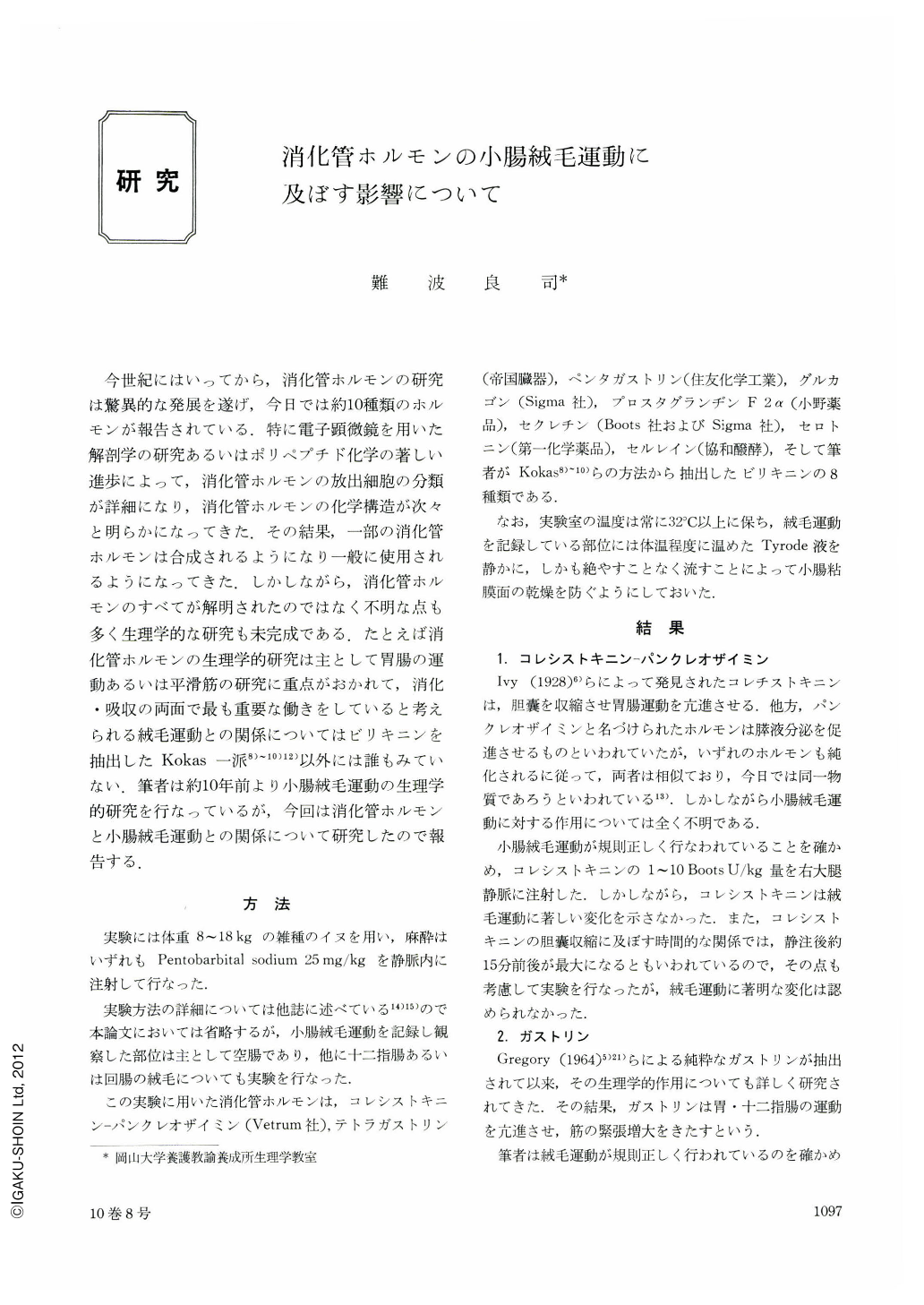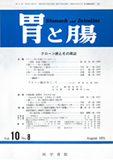Japanese
English
- 有料閲覧
- Abstract 文献概要
- 1ページ目 Look Inside
今世紀にはいってから,消化管ホルモンの研究は驚異的な発展を遂げ,今日では約10種類のホルモンが報告されている.特に電子顕微鏡を用いた解剖学の研究あるいはポリペプチド化学の著しい進歩によって,消化管ホルモンの放出細胞の分類が詳細になり,消化管ホルモンの化学構造が次々と明らかになってきた.その結果,一部の消化管ホルモンは合成されるようになり一般に使用されるようになってきた.しかしながら,消化管ホルモンのすべてが解明されたのではなく不明な点も多く生理学的な研究も未完成である.たとえば消化管ホルモンの生理学的研究は主として胃腸の運動あるいは平滑筋の研究に重点がおかれて,消化・吸収の両面で最も重要な働きをしていると考えられる絨毛運動との関係についてはビリキニンを抽出したKokas一派8)~10)12)以外には誰もみていない.筆者は約10年前より小腸絨毛運動の生理学的研究を行なっているが,今回は消化管ホルモンと小腸絨毛運動との関係について研究したので報告する.
When the internal surface of the small intestine is examined under warm saline solution by means of a low-powered microscope, it is seen that each of the villi is extending and contracting. It is generally believed that these movements accelerate the flow of blood and lymph and that they increase absorption.
Since the discovery of secretin in 1902, the study on the gastrointestinal hormones has developed remarkably. But the relation between the gastrointestinal hormone and the villus movements have yet not been elucidated without villikinin.
In 1933, Kokas and Ludány introduced the concept of hormonal control by demonstrating that the introduction of hydrochloric acid into the duodenum activated the movements of the villi of a jejunal segment, which was removed from the abdominal cavity and was being viviperfused by anastomosis with the external jugular vein and the carotid artery. Crude mucosal extracts from the upper small intestine were shown to stimulate the movements of the villi, and the active hormone was given the name "villikinin".
In the present experiments, dogs weighing 8~18 kg were anesthetized by an intravenous injection of pentobarbital sodium (25 mg/kg) and then the abdominal cavity was incised along the midline as previously described by Nanba et al.14)15) perimental method was described in previous paper by Nanba et al.
As for gastrointestinal hormene, author used cholecystokinin-pancreozymin (Vetrum), tetragastrin (Teikoku Zoki), pentagastrin (Sumitomo Kagaku), glucagon (Sigma), prostaglandins (Ono yakuhin), secresin (Boots pure drug Co. and Sigma chemical Co.) and caerulein (Kyowa Hakko).
Following Kokas and Ludány's method, author extracted crude villikinin from the duodenum of the dog; the intestinal mucosa of a fasting dog was scraped with a glass slide, weighed, emulsified with sand, and extracted with 0.1 N HCl (30 g mucosa/100 ml HCl). The emulsion was brought to boiling, the pH was adjusted to 7.4~7.5 with 40% NaOH, and the emulsion was cooled. The sediment was removed by centrifugation (2,500 rpm, for 30 min.) and discarded. The supernatant fluid was treated with vegetable charcoal which was removed by suction filtration. This filtrate constituting the crude mucosal extracts or villikinin was frozen and stored at -20℃, or lyophilized.
The effects of gastrointestinal hormones on the villus movements were studied in anesthetized dogs. The results are summarized as follows.
1. Serotonin increased remarkably the contractile frequency of the villus movements. Secretin, gastrin and prostaglandins F 2α increased slightly.
2. Glucagon inhibited remarkably the villus movements.
3. Cholecystokinin-pancreozymin had no effect and the villikinin showed no effect in the present experiments.

Copyright © 1975, Igaku-Shoin Ltd. All rights reserved.


